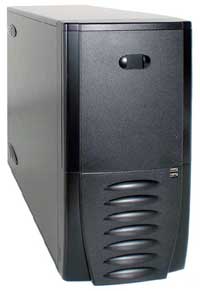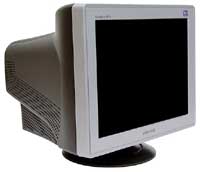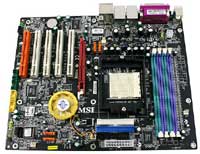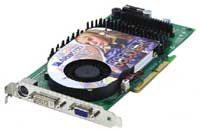AMD Mid-Range Gaming System
If you want some more
oomph in your system - say you like higher resolutions and antialiasing, or maybe you're a competitive online gamer - you could upgrade a few parts in the Budget System and end up with acceptable performance. We're going to kick it up another notch for the Mid-Range segment by improving nearly every component.
| Mid-Range AMD Athlon 64 System |
| Hardware |
Recommended Component |
Price |
| Processor |
AMD Athlon 64 3500+ 512K 2.2 GHz (939) 90nm |
285 |
| Motherboard |
MSI K8N Neo2 Platinum |
131 |
| Memory |
Mushkin Dual Pack 2x512 PC3200 2.5-3-3 |
159 |
| Video Card |
Albatron GeFORCE 6800 GT 256MB GDDR3 |
374 |
| Hard Drive |
Seagate 160GB SATA 7200RPM 8MB Model ST3160023AS |
93 |
| Optical Drive |
NEC DVD+/-RW Drive Model 3500A |
72 |
| Case and Power Supply |
Antec SLK3700-BQE with 350W |
91 |
| Display |
Samsung SyncMaster 997DF 19 CRT |
234 |
| Speakers |
Logitech Z-640 5.1 |
52 |
| Keyboard |
Logitech Internet Keyboard |
17 |
| Mouse |
Microsoft IntelliMouse Optical |
24 |
| Bottom Line |
|
1532 |

Click to enlarge. |
We return to several components that we have recommended in the past for the Mid-Range system. We've doubled the amount of RAM, and we've upgraded the case and PSU to the Antec SLK3700-BQE. It's not a flashy case, so if you're interested in that, you might look elsewhere. Nevertheless, it is a well thought out design, and the use of dual 120mm fans provides ample cooling when you add in the front fan. For the monitor, we have upgraded to a 19" CRT, which has the ability to run at 1600x1200 with a 75 Hz refresh rate. The NEC FE991SB is also an option, although it costs $40 more. We have upgraded to a Serial ATA hard drive with 160GB storage capacity, again staying with Seagate and their five-year warranty. Most of the other base components remain the same, although we opted for the five-button Microsoft IntelliMouse Optical this time.

Click to enlarge. |
The major changes come in the selection of motherboard, CPU, and graphics card. This should come as no surprise, as we have already mentioned several times that these are the most important aspects of a gaming system. For the processor, we have upgraded to an Athlon 64 3500+. The raw clockspeed advantage is not that great, but our
initial tests of the 90nm parts show a slight performance increase relative to the older 130nm 3500+, particularly in games, and it also has better overclocking capabilities if you're interested in that. The power use of the 90 nm parts is also substantially lower than the 130 nm design. The total price increase is $20 relative to the 130nm part, so either one is fine. The motherboard that we have selected uses the NForce3 250 Ultra chipset, and it was also our Gold Editor's Choice in our
Socket 939 Motherboard Roundup. There are several socket 939 motherboards with similar features that use the VIA K8T800 Pro chipset, but we have stuck with the NVIDIA chipset as tests have shown that it has a slight performance advantage when used with an NVIDIA graphics card compared to boards using the VIA chipset. ATI boards do not incur any penalties either, should you choose to go that route. If you prefer the VIA based boards, the Abit AV8 and Asus A8V both received our Silver Editor's Choice.

Click to enlarge. |
Speaking of graphics, our recommendation goes to a GeForce 6800GT AGP model. With 16 pixel pipelines, a 350 MHz GPU core and 1 GHz GDDR3 RAM, it provides nearly twice the performance of the 9800 Pro and significantly more than the 6600GT as well. Performance doesn't vary much if at all between the various manufacturers, so we have selected the card that we could find for the lowest price. You could also look into spending a bit more for a BFG 6800GT OC model that comes factory overclocked or the Leadtek model with it's larger two-slot HSF, but otherwise there is not a whole lot to differentiate among the designs. For ATI lovers, the X800 Pro actually offers very similar performance to the 6800GT. It only has 12 pixel pipelines, but since they're clocked at 475 MHz instead of 350 MHz, it ends up as almost a tie. The 6800GT has faster RAM - 1 GHz compared to 900 MHz - and it also includes Shader Model 3.0 support, not to mention a lower price. If you can find the X800 Pro for less than the 6800GT, though, it's definitely worth considering.

Click to enlarge. |
Then again, the AGP socket could become something of a limitation for upgrades by that time. We have recently previewed the
NForce 4 chipset as well as
ATI's RX480. Both should be available for purchase before the end of the year, and the NVIDIA boards will likely start showing up by the end of this month. If you're considering a socket 939 platform, and assuming you're willing to pay the price premium, it could be worth waiting for the PCI Express motherboards to ship. We'll take a look at PCI Express costs with our Intel Mid-Range alternative. SLI is also a very attractive feature for those looking to buy one card now and upgrade later. All told, an SLI-capable system will probably cost about $100 more than an equivalent AGP setup, but with AGP you're stuck with one graphics card.














70 Comments
View All Comments
SDA - Wednesday, December 1, 2004 - link
Whoops, I'd forgotten all about this thread.400W is fine if that's what you want, since it's your system. I wouldn't recommend to others that they spend much more for a 400W PSU (as opposed to spending more to get a higher-quality 350W or 380W PSU) when the average high-end Athlon 64 rig consumes 230W or so under load, though. I'd define 50% more than is necessary under full load "moderate," how about you?
520W is still overkill for SLI 6800GTs on an A64, although not as bad as 400W is overkill for the average A64. As I recall, SLI 6800Us on a high-end A64 eat something like 350W of power (decked out with HDDs and fans and whatnot, of course). 470W is perfectly fine there (although I'd personally just get a Tagan 480W, which should be the same and cheaper + less gaudy to boot). Again, you're welcome to do what you want, but you have an obligation to research system power consumption before you make recommendations to others.
As for E-Power/Tagan, the amperages really aren't very different. Furthermore, just because they don't look the same doesn't mean they're not. They use very similar components, have an identical layout, and use the same PCB. Trust me, PCB and components say a lot more than paint job ;) Googling Tagan and PowerStream should give you some nice solid evidence (and juicy internals pics!).
Again, nothing against the guide in general.. I just ask that you research the subject more in the future.
JarredWalton - Friday, November 26, 2004 - link
"Moderate PSU" in my book means >=400W these days. If a 350W generic PSU isn't sufficient, are you really going to want to spend $25 to $30 (shipped) for something that is the same wattage but more reliable? Maybe, but I wouldn't. If I buy an add-in PSU, I'll get at least a 400W.520W *is* overkill for most systems, but if you look at what I said it makes sense. If you want SLI with two 6800 GT or 6800 Ultra cards, you're probably going to have two (or more) hard drives and a lot of other stuff as well. I would spend the extra money for the 520W in that case. Regarding the OCZ = Tagan comment, I would have to see some really concrete evidence of that. Judging by The Egg, they're not the same:
http://www.newegg.com/app/viewProductDesc.asp?desc...
http://www.newegg.com/app/viewproductdesc.asp?desc...
The E-Power/Tagan has very different amperages than the OCZ. The shells are also different. Both are quality power supplies, of course, but even if they share some common components, that doesn't make them "the same."
Anyway, the PSU comments are duly noted and I will make sure to mention this item more clearly in the future. Please move on from the PSU comments now... nothing to see here. ;) (If you really want to comment more on the PSUs, you can. I'm only kidding people.)
SDA - Wednesday, November 24, 2004 - link
First thing to say: I don't want to sound insulting or condescending in any way. I think this is a good guide, and it's a lot of work to get a guide that a lot of people agree on as being good-- especially one as extensive as this.Now then. No, a good PSU will NOT add $50+ to the total for the budget systems. Fortron/Sparkle and TTGI power supplies are known to be solid units, if not amazing, and ones of appropriate wattage (300-350 is fine for a PC like the budget box) can be obtained for a reasonable $20-25 new. Is paying an extra 2.5~3% to avoid seeing a cheap POS PSU fail in an amusing fashion (possibly taking parts with it, I saw a Powmax unit take out an XP and mobo) and/or avoid instability worth it? Well, sure, I think so. Would you be willing to save $20 and go with cheap generic memory? Didn't think so.
And yeah, I realize the budget systems aren't meant for overclocking. That doesn't matter. I've been to the AMD official processor support forums too, and I've also worked as a tech support (paid and all, although FWIW a lot of the people that help out on those forums know what they're talking about more than pro tech supports), and I can say for certain that the biggest problem with DIY systems is cheap power supplies. They can be problematic even at stock clock speeds, and it's certainly not as if the budget systems are little old P2s that'll barely eat any power at all.
I'd also like to add, for the sake of balance, that 520W is overkill. Quality > quantity; you don't need a 450W PSU to achieve stability, not even if you're running an insane system. Oh yeah, and OCZ PowerStreams are the same as Tagans, and you can get those for pretty cheap (480W Tagan = ~$80 at the Egg of New).
JarredWalton - Wednesday, November 24, 2004 - link
54: The OCZ PowerStream is undoubtedly a good PSU, particularly for overclocking. That wasn't a primary concern with this Guide, so I didn't mention it as we have repeated that recommendation quite a few times. It's about $140 which is quite a lot for a power supply. On the other hand, for those seriously considering SLI with 6800 GT or Ultra cards, a power supply of that quality would be almost required.PseudoKnight - Wednesday, November 24, 2004 - link
Jarred, try the Logitech MX310. It has the Button4 and 5 on opposite sides like you prefer. (as I do, that's why I got one)Precise - Wednesday, November 24, 2004 - link
In your Oct. 1st Athlon 64 Memory: Rewriting the Rules review Wesley Fink stated:"We found that replacing a well-respected 465 watt PS with a 520 watt PowerStream allowed even higher memory overclocks. This was true with both the power-hungry nVidia 6800 Ultra as well as the more mainstream ATI 9800 PRO. If top memory overclocks on the Athlon 64 is your goal, don't skimp on the power supply. Putting the best PS that you can find in your system will pay off in higher memory overclocks with greater stability"
So if you want the fastest memory/system with overclocking you should get a 520 watt PS per Wesley Fink's own recommendation and review.
Glassmaster - Wednesday, November 24, 2004 - link
"Part of the problem, of course, is that many generic PSUs might work well for a couple months and then fail, and that's something that is nearly impossible to test."That might be a good reason not to recommend them :P. Keep up the good work, I would look forward to a PSU roundup.
Glassmaster.
JarredWalton - Wednesday, November 24, 2004 - link
blckgrffn - It's $40 now, it looks like, and despite the name "Silent Power" the dual 80mm fans are not at all silent. The Polo12 is quieter, but it's also about $30 more. $40 for the 420W Thermaltake isn't too bad, though.As for a PSU roundup, I would have to do a lot more research into that subject before actually doing something like that. There are probably people better qualified to do a PSU roundup than me, of course, but it is an interesting topic. I may run that by some of the others to see if they have any thoughts on the topic. Part of the problem, of course, is that many generic PSUs might work well for a couple months and then fail, and that's something that is nearly impossible to test.
Glassmaster - Tuesday, November 23, 2004 - link
Jarred:Thanks for the response. I make a big deal about it because the weak PSU thing is something that lots of people don't know about that ought to be better publicized. Perhaps a future article could be devoted to this topic?
Glassmaster.
blckgrffn - Tuesday, November 23, 2004 - link
Sigh. And I have personally used 3 and really like them. Man, got to keep myself from hitting the "Post Comment" button for at least five seconds after I think that I am done typing...